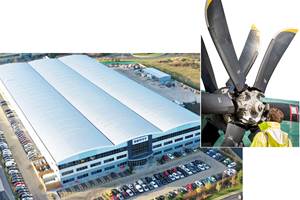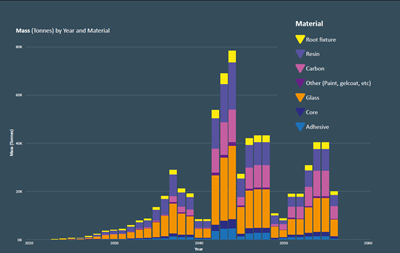Fairmat reaches agreements with Siemens Gamesa, Duqueine, Tarmac Aerosave to recycle composites
Recycled carbon fiber derived from wind turbine blades and aircraft will be transported and analyzed at Fairmat’s facility for consideration in repurposed products.
Share

Photo Credit: Getty Images
Deep-tech company Fairmat (Paris, France) has made several strides toward carbon fiber composites recycling in May 2022 including its first agreement with Siemens Gamesa (Hamburg, Germany) to recycle composite waste from one of the company’s sites in Denmark; a development partnership with the industrial company Duqueine Rhône-Alpes (Civrieux, France), a manufacturer of composite parts for the aeronautical, automotive, medical and sports and recreation industry; and an R&D contract with France-based Tarmac Aerosave, known for its storage, maintenance, transition and recycling of aircraft. These are all add-ons to Fairmat’s original announcement back in Nov. 2021 aiming to recycle Hexcel (Stamford, Conn., U.S.) carbon fiber prepreg.
Under the announced R&D agreement with Siemens Gamesa, Fairmat will collect the composite waste deriving from the manufacturing of wind turbine blades at a Siemens Gamesa production site in Aalborg, Denmark. The waste will next be transported to Fairmat’s production site, FairFactory, located in Bouguenais, to be given a second life in markets such as automotive, mobility, sport and construction.
Following the results of the R&D collaboration, Fairmat and Siemens Gamesa will evaluate the establishment of an ongoing collaboration on the recycling of carbon fiber-reinforced composite waste parts from Siemens Gamesa’s manufacturing processes.
“At Siemens Gamesa we are committed to the transition to a circular economy. We have a desire to minimize the waste from our processes and products, and we rely on partners like Fairmat in our strategic development,” Jonas Jensen, sustainability specialist for Siemens Gamesa, says. “The use of carbon [fiber] composites in the construction of wind turbine blades is likely to increase in the next generation of wind turbines, and it is of utmost importance to SGRE to have sustainable solutions in place to handle the waste materials for this coming volume.”
The company’s new commercial partnership with Duqueine Rhône-Alpes, on the other hand, will enable Fairmat to recycle its production waste, particularly the materials that were used to manufacture the Airbus A350.
Fairmt is expected to recover around 15 tons of waste per year from the Duqueine sites in Massieux and Civrieux, especially from trimming, as well as from “raw” material. The production waste will similarly be transported and repurposed like that of the Siemens Gamesa material waste.
Fairmat believes the partnership represents a supply in carbon fiber-reinforced composites that will strengthen its national operations.
In addition, a major R&D contract signed with Tarmac Aerosave, a subsidiary of France-based Airbus, Safran Aircraft Engines and Suez, will see carbon fiber recycled from end-of-life (EOL) aircraft. Fairmat will also be recovering and analyzing them for possible second life.
If this is successful, Fairmat says it could lead to the signing of a commercial agreement with Tarmac Aerosave for the industrial recovery of all the parts made of carbon fiber-reinforced composites.
Related Content
Materials & Processes: Fabrication methods
There are numerous methods for fabricating composite components. Selection of a method for a particular part, therefore, will depend on the materials, the part design and end-use or application. Here's a guide to selection.
Read MoreMaterials & Processes: Resin matrices for composites
The matrix binds the fiber reinforcement, gives the composite component its shape and determines its surface quality. A composite matrix may be a polymer, ceramic, metal or carbon. Here’s a guide to selection.
Read MorePlant tour: Middle River Aerostructure Systems, Baltimore, Md., U.S.
The historic Martin Aircraft factory is advancing digitized automation for more sustainable production of composite aerostructures.
Read MorePlant tour: Dowty Propellers, Gloucester, U.K.
Transforming decades of design and RTM production reliability into more sustainable, next-generation composite propellers.
Read MoreRead Next
DecomBlades consortium releases specifications for disposal of composite wind blades
The Product Disposal Specifications aim to help industrialize wind blade recycling, detailing materials and components of Siemens Gamesa, Vestas and LM Wind Power blades.
Read MoreViable routes to recycling wind turbine blades found in NCC’s sustainable wind research program
Launched SusWIND program aims to establish a viable circular supply chain to tackle the main challenges of legacy and future composite blades in the U.K.
Read MoreFrom the CW Archives: The tale of the thermoplastic cryotank
In 2006, guest columnist Bob Hartunian related the story of his efforts two decades prior, while at McDonnell Douglas, to develop a thermoplastic composite crytank for hydrogen storage. He learned a lot of lessons.
Read More


























